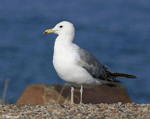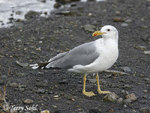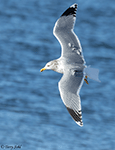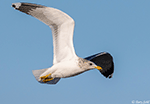| Length: 22 inches | Wingspan: 48 inches | Seasonality: Summer / Migrant |
| ID Keys: Dark eyes, black and red spots on bill tip, greenish-yellow legs, gray back and upper wings, white underparts, white head and neck. Compare to very similar Ring-Billed Gull and Herring Gull. | ||
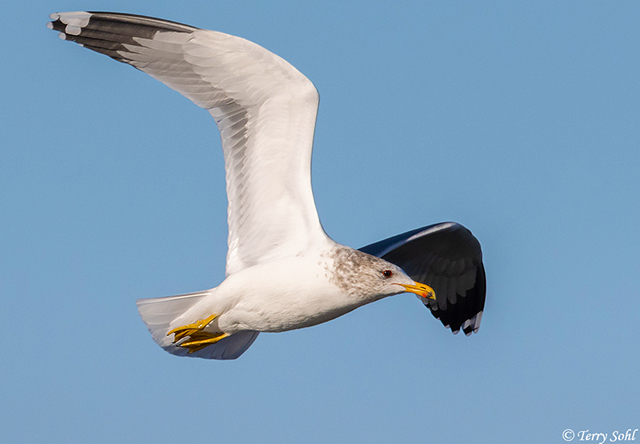 A widespread gull of the
western half of the United States, California Gulls spend their summers in the interior
parts of North America, where the breed in large colonies on inland lakes and
rivers. During the winter months, they are primarily found along the Pacific Coast. The California Gull is what inspired the
seagull monument in Salt Lake City, as it was the species that saved crops from
the 1848 grasshopper plague when they appeared in large numbers to consume the
insects. In South Dakota, they are similar in overall appearance to two other
large gull species, the Ring-Billed
Gull and Herring Gull. Information on
how to differentiate between the species can be found below.
A widespread gull of the
western half of the United States, California Gulls spend their summers in the interior
parts of North America, where the breed in large colonies on inland lakes and
rivers. During the winter months, they are primarily found along the Pacific Coast. The California Gull is what inspired the
seagull monument in Salt Lake City, as it was the species that saved crops from
the 1848 grasshopper plague when they appeared in large numbers to consume the
insects. In South Dakota, they are similar in overall appearance to two other
large gull species, the Ring-Billed
Gull and Herring Gull. Information on
how to differentiate between the species can be found below.
Habitat:
Summers near large freshwater lakes and reservoirs, often utilizing island areas within those water bodies to establish large nesting colonies. California Gulls will often forage in dryland fields and farms for insects. Winters primarily along coastlines, especially near beaches and garbage dumps.
Diet:
California Gulls are omnivores and will feed on a wide variety of items, including insects, fish, eggs and young birds, small mammals, earthworms, crustaceans, small lizards, frogs, carrion, and refuse.
Behavior:
Given their omnivorous nature and tendency to eat whatever food items may be available in a given area, California Gulls will use almost any technique for foraging, from swimming in open water, wading in shallow water, walking on land, or foraging while in flight. They are generally social in nature, nesting in large colonies, and often found together outside of the breeding season, including hanging out with other gull species. Despite their overall gregarious nature, they can be very territorial during the breeding season, aggressively defending nesting sites not only from potential predators, but from other California Gulls in the colony that may stray too close.
Nesting:
June and July in South Dakota. California Gulls are colonial nesters, usually nesting in sometimes very large colonies on islands within shallow lakes of the interior parts of North America. In South Dakota, nesting often occurs on islands in the Missouri River and its associated dammed reservoirs. The nest is a scrape in sandy soil, lined with bits of grasses, weed stems, sticks, and bits of shell or other material that may be close to the nesting site. The female lays between 2 and 4 eggs, with both parents helping to incubate them. The young hatch after about 24 days.
Song:
California Gulls are often a vocal species, with most of the vocalization occurring near nesting sites. They are capable of a wide array of vocalizations. Click below to hear some of the most common ones.
2Click here to hear a 2nd-cycle bird giving loud vocalizations from a group sitting on a beach
3Click here to hear the squeaky vocalizations of a lone winter adult
Migration:
Summers near in the interior west of the United States and Canada. Winters along the Pacific coast and selected locations in the far West. In South Dakota, they're primarily seen during the summer breeding season, as they breed at select locations in the northeastern part of the state, and along the Missouri River (generally islands). They are a rare visitor in winter, but there are a number of records of the species below the dams along the Missouri River in winter.
Interactive eBird Map:
Click to access an interactive eBird map of California Gull sightings
Similar Species:
Can be confused with a number of other Larus gull species. In South Dakota, they're most likely to be confused with the Ring-Billed Gull or Herring Gull. T. Click here for a page with tips on how to differentiate a number of different species of gulls. General identification tips for (adult plumage) California Gulls are as follows:
- Bill: Yellow bill with black and red spot on lower bill
- Legs/Feet: Yellow to greenish yellow
- Upperparts/Mantle - Darker grey than the other common gulls in South Dakota (Ring-billed, Herring). Can be difficult to judge if one species is seen without the context of the other species.
- Eye: Dark eye. Breeding birds have a thin red orbital ring around the eye
- Size: Intermediate in size for the three common, similar species. In order of size from smallest to largest, it's Ring-billed, California, then Herring Gull.
Conservation Status:
Systematic surveys over the last several decades show that populations of California Gull have been in decline. However, they are still found across a very broad geographic area, have strong numbers overall, and are common in parts of their range. The IUCN considers the California Gull to be a species of "Least Concern".
Further Information:
2) Audubon Guide - California Gull
Photo Information:
January 2nd, 2021 -- Near Pierre, South Dakota -- Terry Sohl
Additional Photos:
Click on the image chips or text links below for additional, higher-resolution California Gull photos.
Audio File Credits:
1Andrew Spencer. Recorded in Musselshell County, Montana on July 16th, 2014. Original information and recording available from xeno-canto.
2Andrew Spencer. Recorded in Clallam County, Washington on September 10th, 2012. Original information and recording available from xeno-canto.
3Paul Marvin. Recorded in San Diego County, California on February 7th, 2017. Original information and recording available from xeno-canto.
| Click on the map below for a higher-resolution view |
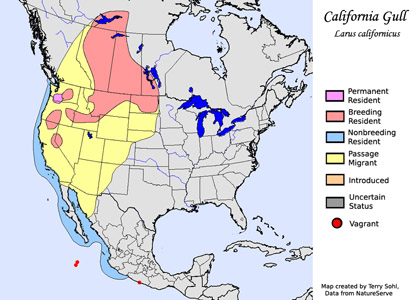 |
| South Dakota Status: Rare migrant. Uncommon and local summer breeding resident in the northeast and select spots on the Missouri River. |
Additional California Gull Photos
Click for a higher-resolution version of these photos
